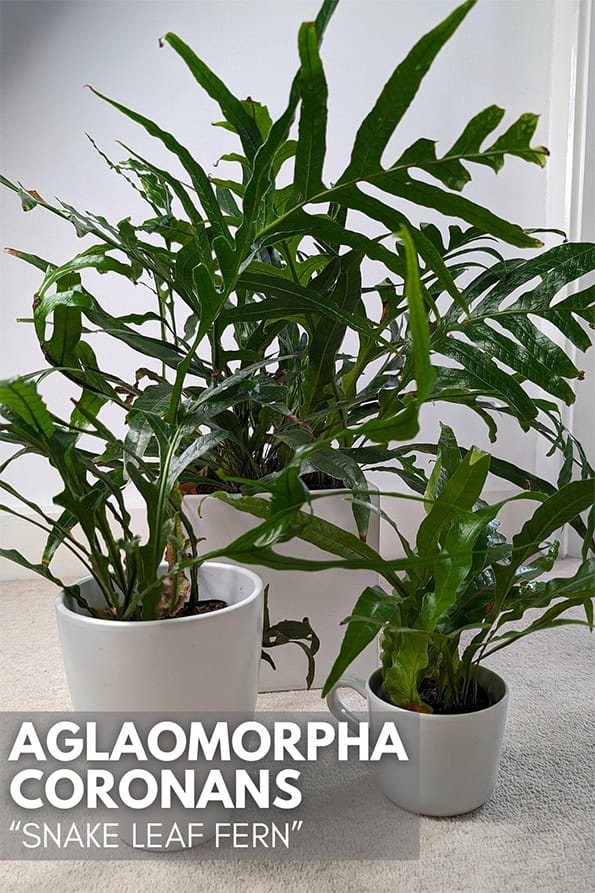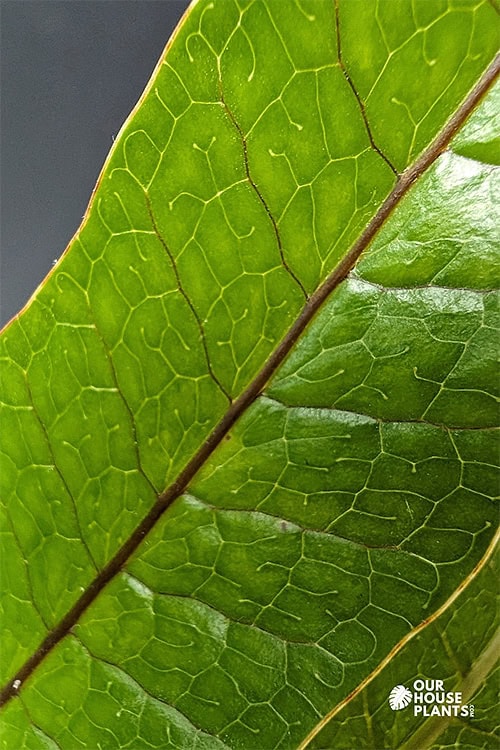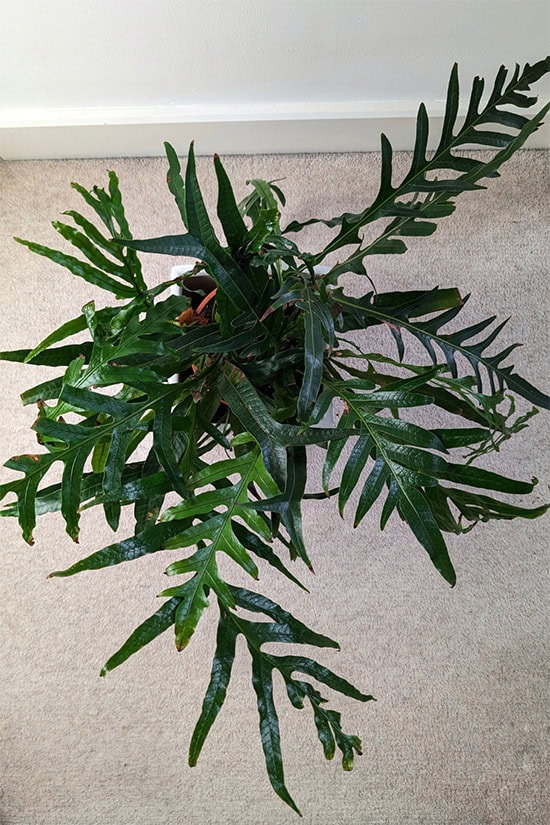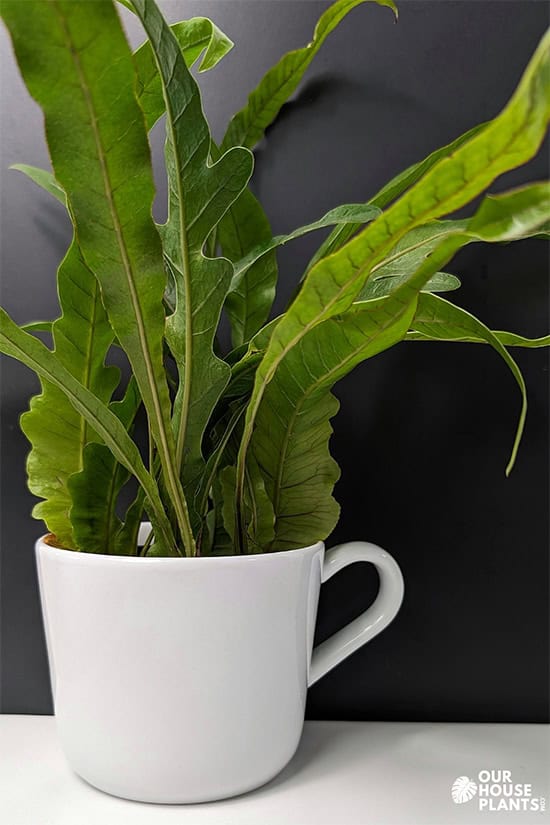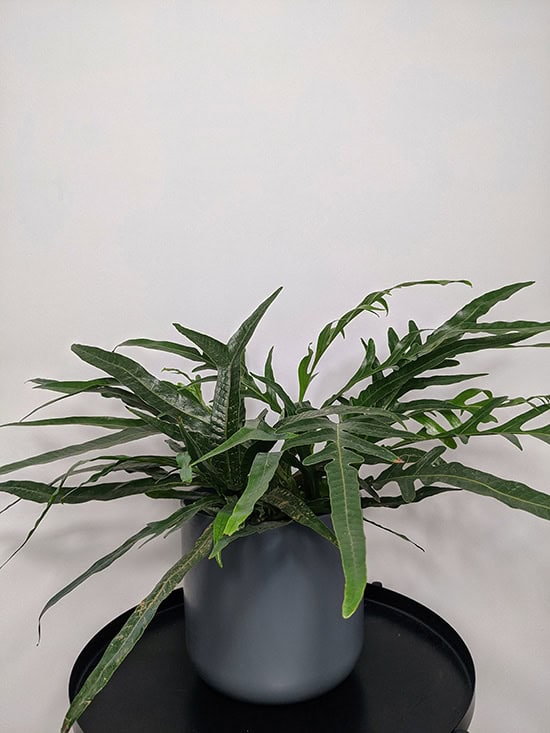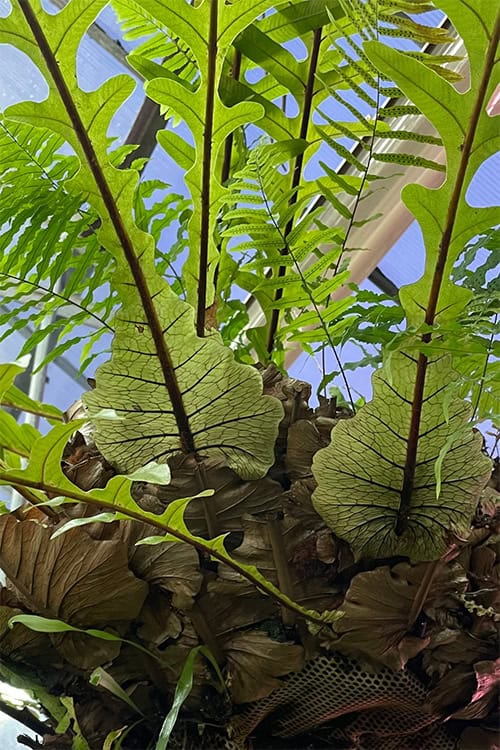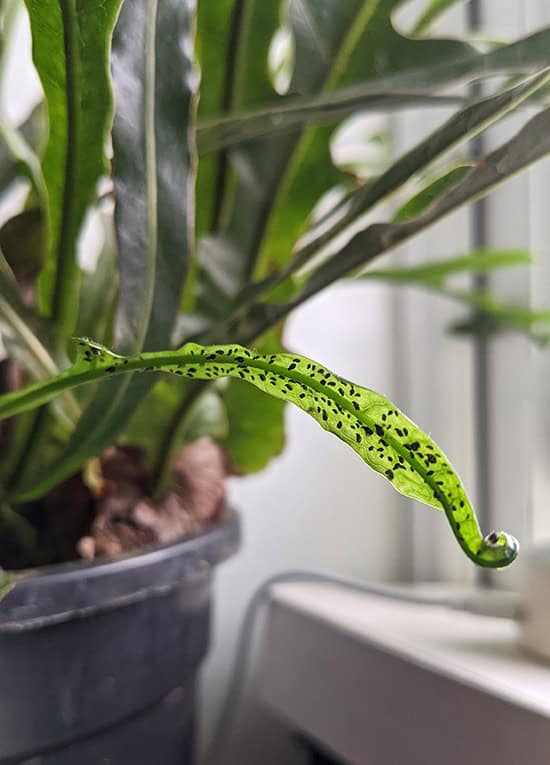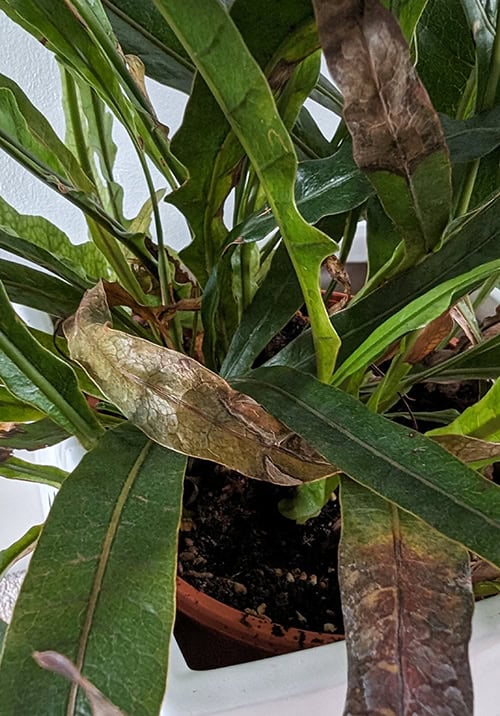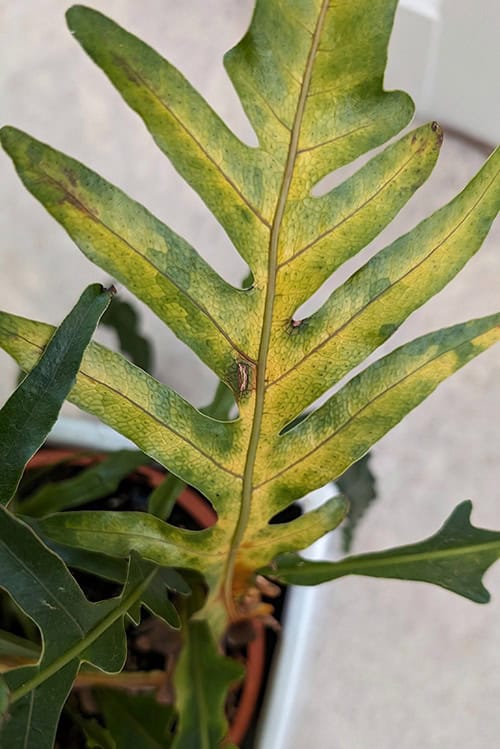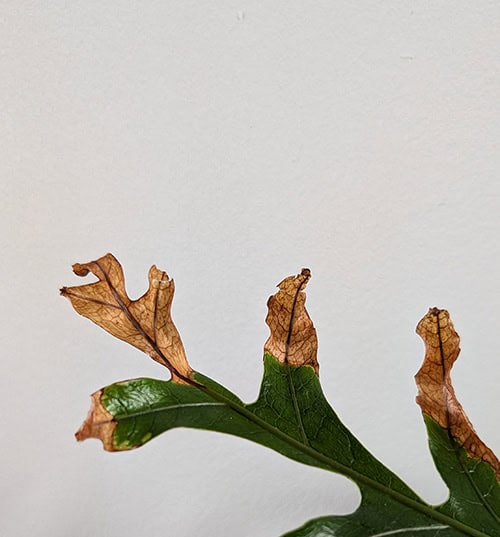Unusual and hard to come by, but worth looking for because Aglaomorpha coronans makes a brilliant houseplant. It can put up with worse care and is more tolerant of indoor environments than most other ferns grown indoors.
It's commonly known as the "Snake Leaf Fern" because of its glossy and leathery fronds. Native to Southeast Asia, it thrives in humid, shaded environments, often growing on trees in rainforests. However, it will adapt to life in our homes and perform well.
Aglaomorpha coronans - Snake Leaf Ferns - They can start off as small plants and after a few years of good care, will become large indoor plants.
I find these plants have a strong ferny look about them. Think Jurassic Park with its prehistoric vibes. Their dark green fronds can be extremely atmospheric in the right setting.
Many other ferns have a lacy and tranquil look about them, but Aglaomorpha coronans has a structural feeling to the foliage. The fronds eventually become quite ridged, holding themselves easily in place and helping to set the scene.
How do you pronounce Aglaomorpha coronans correctly? Say:
Ag-lay-oh-MOR-fuh kor-oh-nanz
It has two common names, the Basket Fern on account of its shield fronds that grow to form a basket like shape (more on that here).
The second name is goes by is the Snake Leaf Fern. This is because the fronds it grows have a segmented, scaly, dry, and leathery feel. Once you've seen one up close the comparison to a snake is obvious to see.
Grown in a bright spot the markings and veining are more pronounced, but they're still visible even in a lower lit location. They often remind people of Snake Skin, hence its common name - Snake Leaf Fern.
Aglaomorpha coronans has visual traits from a mix of different houseplants. It has the shiny glossy fronds of the Birds Nest Fern and Kangaroo Fern. The ridged and inflexible leaves on the Saga Palm and the furry creeping rhizomes found on the Rabbit's Foot Fern. If you like any of those plants, you may be partial to the Snake Leaf Fern.
Belonging to the Polypodiaceae family, it's directly related to the more popular Staghorn Fern and Blue Star Fern. Sometimes these two plants can be tricky to grow indoors and can be short lived, but in my experience Aglaomorpha coronans is much easier and thankfully, more forgiving of mistakes.
Despite all its great traits, it's one of those "under the radar plants". I've only ever seen it for sale in person a handful of times. If you can shop online then your options expand considerably.
Once you've found it, they can be quite expensive. If you're a fan of the way it grows and you like the dark green fronds I think it's well worth considering. (I mean I have three of these plants now, so clearly I'm a big fan of these gems).
Over time the Snake Leaf Fern will grow dark green glossy large leaves. Once it reaches a large mature form, the fronds will split and have interesting details like this one.
They can be propagated very easily (and I'll cover this later), so young small plants should be more reasonable in terms of price. But a larger plant will set you back.

Hi, I'm Tom!
If you're like me and enjoy the challenge of growing houseplants and getting them to thrive, then Ourhouseplants can help. This website shares my knowledge and years of growing plants and provides (hopefully) helpful advice on properly caring for your indoor plant friends.
Fairly tolerant. Can be grown in a wide range of light levels. They will cope with some direct sun, but you need to watch out for leaf scorch as this indicates the light is too strong and needs a darker spot. Plants grown in very bright light tend to be a lighter green and often have a slight red veining in the leaves.
Will adapt to a lower light area at the expense of growth. Leaves in darker areas are usually quite a bit darker than those in higher light.
Little and Often vs a Heavy Soak.
The roots grow slowly and can be quite shallow at times. This is one plant that would be accommodating of a little and often approach with its watering, compared to less frequent heavy soakings. If you're trying to achieve a "just moist" potting mix, the little and often method works well (that's how I grow mine).
Aglaomorpha coronans prefers to be grown in a damp potting medium. They dislike too much water so heavy water absorbent soils should be avoided to prevent mistakes.
They can dry out fully and will be okay with this for a short while. They do better with short droughts as their thick rhizome stores water and their leathery leaves help prevent water loss. However like most ferns, if left like this for longer periods your plant will show underwatering issues.
Water regularly in warmer weather, especially if the plant is being grown in bright light. They need a lot less water when the light levels are lower and temperatures are cooler.
When it's a little plant, they're excellent houseplants for unusual planters. Grow it using contrasting colors to make it pop.
Compared to other ferns, Aglaomorpha is more tolerant of lower humidity levels. So it's a good choice if you struggle to grow most common ferns due to humidity issues. It is a tropical fern though and is both adapted and prefers higher levels of humidity if possible.
Not a gross feeder and you will only need to feed it sporadically. A standard houseplant fertilizer will be fine, but you can also use one designed for ferns.
It's an excellent houseplant for a warm kitchen, but also suitable for areas of low humidity. They're incredibly versatile and will grow in most locations without grumbling too much.
Will cope with a wide range of temperatures. They can deal with temperates as low as 5°C (41°F) and will be fine with higher ranges of up to 40°C (104°F). They may still cope outside of this range in certain situations.
In their native habitats they grow as an epiphyte, so their root system is not as complex or extensive as the roots on other more "traditional" houseplants. This means your Snake Leaf Fern will take a long time to outgrow its container and will often do better in smaller pots.
Think about repotting your plant when it's become congested and cramped at the surface level. There needs to be space for the plant to "spread" to allow it to grow more fronds. You should also think about a repot when the roots have completely filled the potting container. You'll unlikely to be doing it more than every two or three years.
A free draining mix is pretty much essential. They do not like heavy, water retaining soils or potting mixes. Peat and garden soil should be avoided as they hold too much water for optimal growth.
You may get around this by only gently watering your plant, little and often, rather than heavily soaking them. However there is a degree of risk with this approach in the form of overwatering. I'd only recommend trying this if you're an experienced indoor plant grower. If you're fairly new to plants, just use a free draining potting mix that won't hold too much water and removes the overwatering risk.
Give the roots space to breathe and let water run through by using a mix that is designed for ferns or succulents. If the succulent mix is too free draining for your tastes, then amend with some coconut coir, loam or a small amount of worm castings to help hold more water.
Like all ferns, Aglaomorpha coronans will produce spores along its leaves when it reaches maturity (and is happy in your care). However germinating them is a specialist skill and not something most people (including me) want to do.
Instead, it's quicker and more straight forward to propagate through division or cuttings. It's highly effective and you should get fast and sustained quick growth.
Here is my propagation attempt with three small rhizome sections. Each one had a few fronds attached. This photo was taken two months later in March, and you can see three fiddleheads growing and emerging (one from each section). They grew fast and here is the same plant in September that year.
All you need to do is unpot the plant and gently separate it. Everything is attached together with the orange furry rhizomes, a healthy established plant will have multiple parts and they can snap or break apart very easily.
If you don't want to break up the main plant you can take "cuttings" by removing some of the outer, newer rhizome growth. Ideally the removed section should be an inch or so in length and for best results it should have a frond / leaf already growing from it.
Place them in a free draining potting mix. You can leave them on the soil surface, but for stability and better contact with the potting media I push mine firmly into the mix. This will encourage faster rooting. They should not be buried entirely.
Good light levels, warmth and keeping the potting mix moist will speed up the establishing process.
They're generally considered to be slow growers. This is especially true if you're growing it in a lower light setting. However if you've positioned your plant in a warm and bright location, during the Spring and Summer you should see moderate growth speeds.
They will produce less growth over the cooler months of the year regardless of position unless you supplement with grow lights (this is totally optional and not something I would especially recommend, unless you're desperate for constant growth all year round).
The type of growth you get largely depends on the age of the plant. Young plants will produce quite basic fronds that are quite short and have a degree of flexibility even when fully emerged.
As the plant establishes and becomes more mature after a few years, it will produce more elaborate fronds, which are larger and have more splits. Once the frond establishes itself fully (usually a few months after it completely unfurls), it will harden up and become quite tough.
You can expect simple looking foliage on young plants and then more complex growth once it matures.
Shield Fronds are another type of growth that can appear on both young and mature plants. You can read more about them below.
In their native environments they can produce fronds that reach almost 2 meters. However indoors they'll never come close to this size. That said it will still become quite a large and bushy plant over the years.
How to Grow Them
They're very similar to Staghorn ferns in that they can be mounted to a piece of bark and attached to a wall. However for most people this can be tricky and not the aesthetic for a normal home. They'll grow in a normal houseplant planter and you can also try them in a hanging basket if that's your style.
The fronds typically emerge and fan out in a circular fashion, so they won't look their best pushed into a corner or placed tightly up against a wall. Doing this can also cause the foliage to deform. Try to position them somewhere they have a little space all around.
Ferns do not produce flowers. However you may notice spores on the underside of the fronds.
Frequently mistaken for pests, but actually harmless and nature. Some people who are very sensitive to pollen may be irritated by the spores. Move the plant away from your living spaces if you find that they irritate you. They won't last more than a month or so and then you can move them back.
Usually I can get a firm answer about toxicity for most houseplants. However I've been unable to do this for the Snake Leaf Fern (currently!). A lot of websites say they are not pet friendly, but then provide no evidence for this or explain why they're dangerous. In the era of A.I writing, this could easily be regurgitated garbage and misinformation.
I've tried to find a reliable source but have yet to find one. So for now you should play it safe and assume they're not suitable to have around pets that are known to eat or play with your plants.
Sometimes your Aglaomorpha coronans will produce a different type of frond called a Shield Frond. This leaf will emerge from the plant as usual and could have the length of other recently growing fronds. However at the base it becomes quite wide you can see a number of these in the photo below.
In their natural habitat they will grow into a impressive epiphytic fern. They're called Basket Ferns because the shield fronds they grow will form a basket that helps trap organic matter around their roots to fertilize the plant - Photo by Afanasovich
Shield Fronds have a more limited lifespan and will brown up. They will grow in a way that forms a natural basket or net (this is sometimes why people call this plant the "Basket Fern"). This is because the plant is an epiphyte and this basket becomes a natural planter than helps protect the roots, anchors it in place and traps moisture.
It's generally advised not to remove them from your plant. I've not been growing Aglaomorpha coronans long enough to establish if there are long term consequences of removing the brown shield fronds.
In theory as most people are growing them in containers with a potting mix, rather than as an epiphyte I'm dubious that they would be too unhappy if you did tidy them up a little. However you need to make that choice for yourself. I'll update this section if I discover or observe anything interesting.
Pests.
Not prone to pests, but can be afflicted by the usual ones like Aphids, Scale and Thrips. If you suspect a pest, check out my identification guide for confirmation and recommend treatment ideas.
Aphids can be a problem with these plants, but they're one of the easier pests to deal with.
Brown Fronds / Leaves.
This can be reasonably common and has a number of potential causes.
Brown Fronds are usually a sign of poor growing conditions. Evaluate how you're growing your plant, change things up and things will improve.
Yellow Fronds / Leaves.
Yellowing can be caused by similar issues as the browning.
Yellowing leaf fronds. Often caused by too much water and too little light.
Bent / Damaged Fronds.
When fronds first start growing they're typically a light green, soft and have a lot of flexibility. Once they start maturing the harden up and become more rigid. If the new frond is growing up against a wall or a surface that creating a bending in it's natural shape, it will eventually "set" into this position and have a permanent bend.
This bending and curling can be avoided by growing your plant away from corners or avoiding it being pressed up against a wall. Give your Snake Leaf Fern a little space to spread out and fill the area.
Brown tips / ends.
Poor watering technique (usually not enough) and combined with low humidity levels can trigger browning on the end of fronds. The foliage may also look less green, washed out or faded. Once brown you can't turn them green again.
If they're too distracting, you can carefully trim off the brown sections at the end of the fronds. It will make a lot of difference visually and is worth the 5 minutes to do it.
